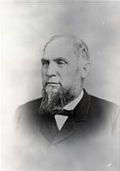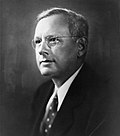Top Qs
Timeline
Chat
Perspective
List of governors of Kansas
From Wikipedia, the free encyclopedia
Remove ads
The governor of Kansas is the head of state of Kansas[2] and the commander-in-chief of the state's military forces.[3] The governor has a duty to enforce state laws,[2] and the power to either approve or veto bills passed by the Kansas Legislature,[4] to convene the legislature at any time,[5] and to grant pardons.[6]
Since becoming a state, Kansas has had 48 governors. The state's longest-serving governors were Robert Docking, John W. Carlin, and Bill Graves, each of whom served 8 years (Docking served four two-year terms; Carlin and Graves each served 2 4-year terms). The shortest-serving governor was John McCuish, who served only 11 days after the resignation of Fred Hall.
The current governor is Democrat Laura Kelly, who took office on January 14, 2019.
Remove ads
List of governors
Summarize
Perspective
Kansas Territory
Kansas Territory was organized on May 30, 1854, from land that had previously been part of Missouri Territory.[7] Despite existing only for six years, it had six governors appointed by the president of the United States.
State of Kansas

The eastern bulk of Kansas Territory was admitted to the Union as Kansas on January 29, 1861.[25] The Kansas Constitution provided that a governor and lieutenant governor be elected every 2 years, for a term commencing on the second Monday in the January after the election.[26] An amendment in 1972 increased terms to four years, with a limit that a governor could not serve more than two terms in a row, and provided that the governor and lieutenant governor are elected on the same ticket.[27] In the original constitution, should the office of governor be vacant, the powers would devolve upon the lieutenant governor, who nonetheless would remain in that office;[28] the 1972 amendment changed it so that, in such an event, the lieutenant governor becomes governor.[29]
Until 2018, there was no age or residency requirement to run for the office; in 2017, three teenagers were doing so.[30] In 2018, a law was passed establishing the age to run for governor and lieutenant governor at 25.[31]
Remove ads
Timeline
| Timeline of Kansas governors |
 |
See also
Notes
- The range given is from the date the governor was confirmed by the Senate, or appointed by the President during a Senate recess, to the date the governor left office.
- Reeder was dismissed by President Franklin Pierce, "on the tenuous grounds of illegal land speculation" when he refused another appointment.[8]
- Medary resigned following the election of Abraham Lincoln to president;[21] he had already lost the election to be the first state governor.[24]
- Lieutenant governors represented the same party as their governor unless noted.
- Represented the Republican Party
- Humphrey instead ran unsuccessfully for the United States House of Representatives.[71]
- Stubbs instead ran unsuccessfully for the United States Senate.[99]
- Capper was instead elected to the United States Senate.[107]
- Landon instead ran unsuccessfully for President of the United States.[131]
- Carlson resigned; he had been elected to the United States Senate to replace Harry Darby, and Darby resigned early so that Carlson could be appointed to the seat early by his replacement as governor, Frank L. Hagaman.[147]
- Hagaman had already lost the Republican nomination to Edward F. Arn.[151]
- Hall resigned so that his successor would appoint him to the Kansas Supreme Court; he had already lost the Republican nomination to Warren W. Shaw.[158]
- First term under a 1972 constitutional amendment which lengthened terms to four years.
- Sebelius resigned, having been confirmed as United States Secretary of Health and Human Services.
- Brownback resigned, having been confirmed as United States Ambassador-at-Large for International Religious Freedom.
- Colyer lost the Republican nomination to Kris Kobach.
- Kelly's second term began on January 9, 2023,[213] and will expire on January 11, 2027; she will be term-limited.
Remove ads
References
External links
Wikiwand - on
Seamless Wikipedia browsing. On steroids.
Remove ads
























































